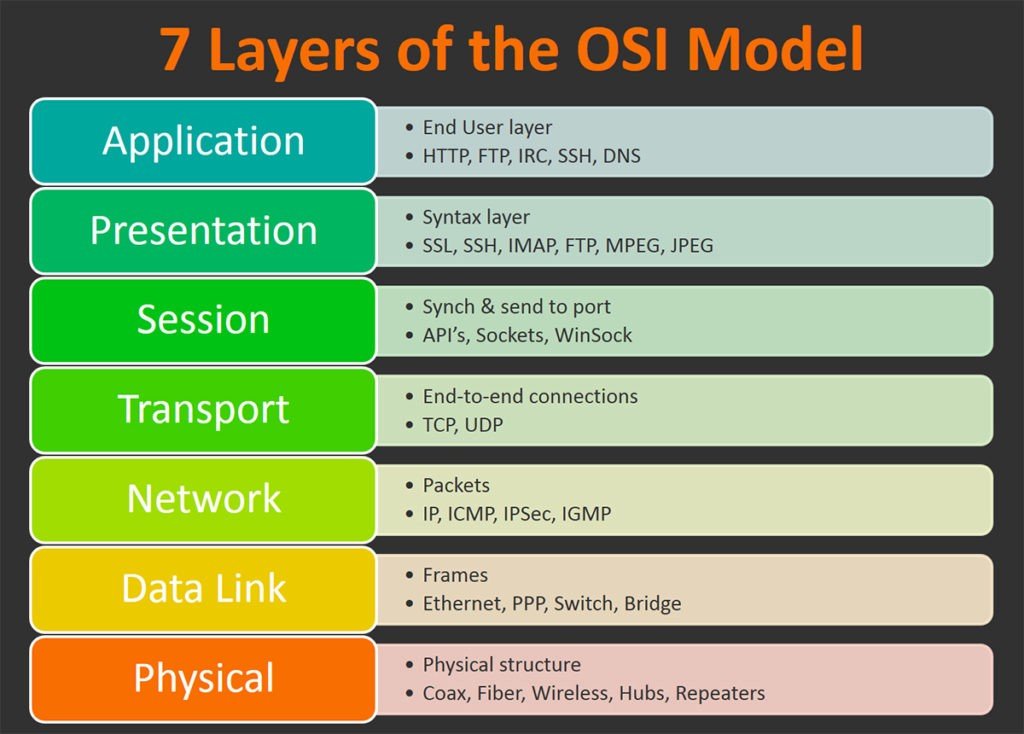In the world of networking, the OSI (Open Systems Interconnection) model is a fundamental concept that helps standardize the way different systems communicate over a network. It divides the communication process into seven distinct layers, each with its own functions and responsibilities.

The Open Systems Interconnection (OSI) model describes seven layers that computer systems use to communicate over a network. It was the first standard model for network communications, adopted by all major computer and telecommunication companies in the early 1980s.
The modern Internet is not based on OSI, but on the simpler TCP/IP model. However, the OSI 7-layer model is still widely used, as it helps visualize and communicate how networks operate, and helps isolate and troubleshoot networking problems.
OSI was introduced in 1983 by representatives of the major computer and telecom companies, and was adopted by ISO as an international standard in 1984.
Let’s take a closer look at each layer:
1. Physical Layer
The Physical layer is the foundation of the OSI model. It deals with the physical connection between devices, including cables, switches, and other hardware. This layer is responsible for the transmission and reception of raw bit streams over a physical medium. Think of it as the actual cables and signals that connect computers.
2. Data Link Layer
The Data Link layer is responsible for establishing a reliable link between two directly connected nodes. It handles error detection and correction from the Physical layer, and it controls the flow of data. This layer is divided into two sublayers: the MAC (Media Access Control) layer, which controls how devices on the network gain access to the medium, and the LLC (Logical Link Control) layer, which manages frame synchronization, flow control, and error checking.
3. Network Layer
The Network layer is responsible for determining the best path for data to travel from the source to the destination. It manages logical addressing through IP addresses, handles packet forwarding, routing, and congestion control. Routers operate at this layer, making decisions about the most efficient route for data packets.
4. Transport Layer
The Transport layer ensures that data is transferred from point A to point B reliably and without errors. It provides end-to-end communication control and error recovery. This layer uses protocols like TCP (Transmission Control Protocol) and UDP (User Datagram Protocol) to manage data transmission. TCP ensures reliable transmission with error checking and flow control, while UDP offers a faster but less reliable option.
5. Session Layer
The Session layer is responsible for establishing, managing, and terminating connections between applications. It provides full-duplex, half-duplex, or simplex operation, and handles session checkpoints and recovery, making sure that the data exchange process can be properly restarted if interrupted.
6. Presentation Layer
The Presentation layer acts as the translator between the network and the application. It manages data encoding and encryption, ensuring that data is presented in a readable format. This layer is responsible for data compression, encryption, and decryption, allowing different systems to communicate effectively.
7. Application Layer
The Application layer is the closest to the end user. It provides network services directly to user applications and is responsible for various protocols such as HTTP (Hypertext Transfer Protocol), FTP (File Transfer Protocol), and SMTP (Simple Mail Transfer Protocol). This layer enables user interaction with the network through applications like web browsers, email clients, and file transfer tools.
Conclusion
The OSI model is a crucial framework in networking, breaking down the complex process of data communication into manageable layers. Each layer has a specific role, working together to ensure that data is transmitted accurately and efficiently from one device to another. Understanding the OSI model is essential for anyone involved in network design, management, and troubleshooting.
